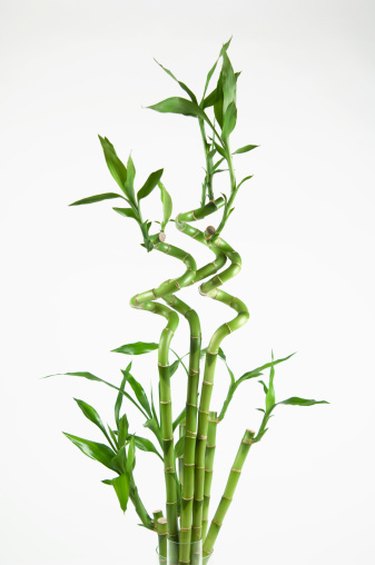
Dracaenas are tropical plants grown for their foliage, which is often striped. Some varieties also produce clusters of white, lavender or red flowers. Although diseases aren't usually a problem for home gardeners, there are a few problems that can cause leaves to turn yellow.
Lighting
Video of the Day
Yellowing leaves can indicate that your plants aren't receiving enough light. Light from a window may be sufficient if your plant is placed on the sill, but not if it's placed farther away from the window. Dracaenas require moderate amounts of light. Fluorescent lights placed 10 to 14 inches above your plants will give them the light they need.
Video of the Day
Water/Fertilizer
Underwatering or overwatering causes Dracaena leaves to turn yellow and drop. Only water plants if the surface soil is dry. When watering, add water until it runs out of the drainage holes in the bottom of the pot. Repeat, after a few minutes, until the water runs out of the holes again. Empty excess water from the pot tray. Yellow tips and margins can mean you're overfertilizing your plants. Dracaenas don't need to be fertilized more than once a month during the growing season.
Temperature
Dracaenas prefer daytime temperatures between 60 and 70 degrees Fahrenheit, and nighttime temperatures between 50 and 60 degrees. Some varieties of Dracaena, like D. marginata, develop yellow bands on their leaves when exposed to temperatures between 32 and 37 degrees. Temperatures above 90 degrees can cause leaves to turn yellow with green veins.
Nutritional Deficiencies
Two common deficiencies found in plants are nitrogen and iron. When plants are deficient in nitrogen, the older leaves turn yellowish and the plant doesn't produce many new leaves. Iron deficiency causes leaves to turn yellow with green veins. Iron deficiencies can be due to soil that's too alkaline, but nutritional deficiencies aren't always caused by problems with the soil. Instead diseases, nematodes or water-logged soil can make it difficult for plants to absorb needed nutrients from the soil.
Fluoride
Fluoride poisoning can cause leaf tips and margins to turn yellow and brown areas to appear on the leaves. Don't use potting soil containing perlite or fertilizers that contain superphosphate because these contain fluoride. Don't water plants with water containing 1 ppm or more fluoride.
Verticillium Wilt
Verticillium wilt is a fungal infection that causes leaves to wilt and turn yellow or red between the veins. Leaves may also curl and fall off the plant, and the vascular tissue becomes discolored. There are no cures for verticillium wilt. Newly infected plants should be fertilized and watered to keep them as healthy as possible. Use fertilizer that's higher in potassium and lower in nitrogen. Prune infected plant parts and destroy them. Sterilize pruning tools after each cut. When removing plants that have been killed by this disease, remove as much of the root system as possible.
Spider Mites
Spider mites are tiny creatures less than 1/20th of an inch long that live in colonies on the undersides of Dracaena leaves. They damage plants by feeding on the sap. Leaves become speckled with dots and later turn yellow and fall off. Spider mites produce a fine web on leaves and twigs. The damage they cause is usually only aesthetic, but severe infestations can kill plants. Natural enemies like ladybird beetles and predatory mites usually control mites. You can also reduce numbers by washing them off your plants with a strong spray of water, or using insecticidal soaps and oils.
- Penn State University Extension; Dracaena Diseases; Gary W. Moorman
- Clemson Cooperative Extension; Dracaena; Karen Russ; March 1999
- University of Florida Extension; Cultural Guidelines For…Dracaena; Dennis B. McConnell, et. al.
- Purdue University Dept. of Horticulture; Indoor Plant Care; B. Rosie Lerner
- University of California Statewide Integrated Pest Management Program; Dracaena, Corn Plant, Dragon Tree, Ti Tree
- University of California Statewide Integrated Pest Management Program: Mineral Deficiency
- University of California Statewide Integrated Pest Management Program: Mineral Deficiencies
- University of California Statewide Integrated Pest Management Program: Spider Mites
- University of Illinois Extension Focus on Plant Problems; Verticillium Wilt; James Schuster